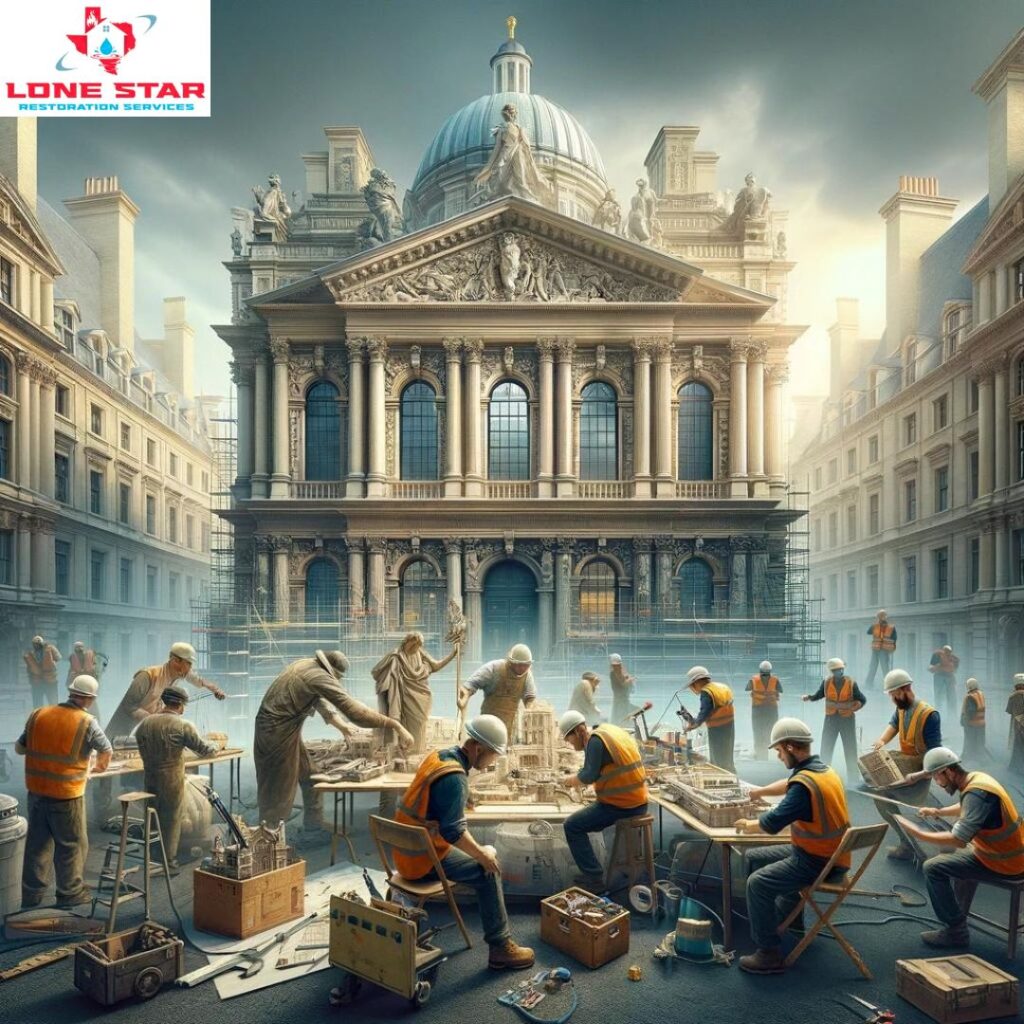Breathing New Life into History: Cutting-Edge Approaches to Restoring Heritage Buildings
In the heart of every historical building lies a story, a testament to the architectural prowess and cultural heritage of its time. At Lone Star Restoration, we are passionately committed to bringing these stories back to life through the meticulous restoration of historical structures. Our mission transcends the mere preservation of physical forms; it’s about reviving the soul of the past, ensuring that each building continues to narrate its story to future generations. This endeavor is not just about nostalgia but about respecting our collective heritage and learning from the architectural achievements of our predecessors.
Historical building restoration stands at the crossroads of art and science, demanding a deep understanding of traditional craftsmanship techniques while embracing the potential of modern technology. The challenge is to mend the ravages of time, not by erasing the marks of history, but by integrating them into a revitalized structure that honors its original essence. This delicate balance requires not only expertise but a profound respect for the past.
As a leader in innovative restoration techniques, Lone Star Restoration embodies this philosophy in every project we undertake. Our approach is holistic, combining rigorous historical research with the latest advancements in restoration technology. From the majestic facades of grand edifices to the intricate details of interior woodwork, our team is dedicated to restoring the beauty and integrity of historical buildings, ensuring they stand proud for centuries to come.
The importance of this work cannot be overstated. In a world that is rapidly changing, these buildings serve as anchors, connecting us to our history, our culture, and our shared human experience. By preserving them, we not only honor the craftsmanship and vision of the past but also provide a source of inspiration and knowledge for the future.
In this blog, we delve into the innovative techniques at the forefront of historical building restoration, illustrating how Lone Star Restoration is pioneering new methods to safeguard our architectural heritage. Join us as we explore the intricate process of reviving the past, blending the best of tradition and innovation to breathe new life into our most cherished historical landmarks.
The Philosophy Behind Historical Restoration
At the core of historical building restoration lies a deeply rooted philosophy that transcends mere construction or renovation. This philosophy is anchored in the belief that buildings are not just physical structures but vessels of historical, cultural, and aesthetic value. Lone Star Restoration operates under this guiding principle, viewing each restoration project as a stewardship of history, tasked with the responsibility of preserving the architectural legacy for future generations.
The ethics of restoration are complex and multifaceted, balancing the need to maintain historical accuracy with the practicalities of modern use and safety. It’s a dialogue between the past and the present, where every decision must consider the original intent of the building’s creators alongside contemporary needs. This balance is delicate; it requires a deep understanding of historical context, an appreciation for the original craftsmanship, and a thoughtful application of modern techniques.
Preserving historical integrity means more than just maintaining the outward appearance of a building. It involves an intricate process of understanding the materials, techniques, and cultural significance of the original structure. This process begins with extensive research and documentation, piecing together the building’s history to inform restoration decisions. Lone Star Restoration prides itself on this scholarly approach, leveraging archival research, historical photographs, and even oral histories to ensure that each restoration project is as authentic as possible.
Yet, respecting the original architecture doesn’t mean shying away from modern advancements. The philosophy behind our work embraces the use of contemporary materials and methods, provided they enhance the building’s longevity without detracting from its historical essence. This includes the integration of sustainable practices and modern amenities, ensuring that restored buildings are not only more accessible but also more environmentally friendly.
The goal is to create a seamless blend of old and new, where modern interventions are carefully designed to be reversible, preserving the option for future generations to return the building to its original state if desired. This approach reflects a deep respect for the past, acknowledging that we are but temporary guardians of these architectural treasures.
By adhering to this philosophy, Lone Star Restoration not only contributes to the preservation of physical structures but also ensures the continuation of stories, traditions, and memories embedded within these historical edifices. It’s a testament to our belief that buildings, much like books, hold the power to connect us to the past, teach us about our heritage, and inspire us to envision a future that honors the beauty and wisdom of bygone eras.
Assessment and Planning: The First Steps
The journey of restoring a historical building begins long before any physical work is undertaken. This initial phase of assessment and planning is critical, laying the foundation for a project that respects the building’s historical significance while addressing its current needs. Lone Star Restoration approaches this phase with the meticulousness it demands, understanding that the success of the restoration hinges on the thoroughness of these early steps.
Assessment: Understanding the Past and Present
The first step in any restoration project is a comprehensive assessment of the building’s current condition. This involves a detailed inspection of the structure, identifying areas of damage, deterioration, and any alterations made over the years. Lone Star Restoration employs a range of techniques in this process, from hands-on examinations to advanced technologies like 3D scanning and infrared imaging. These tools allow us to uncover hidden issues, from structural weaknesses buried within walls to ancient frescoes obscured by centuries of grime.
Equally important to this physical assessment is an understanding of the building’s history. Our team dives into historical records, architectural drawings, and any other available documentation to piece together the original design and subsequent changes. This research is crucial not only for understanding the building’s architectural significance but also for uncovering lost techniques and materials that may be integral to its restoration.
Planning: Charting a Course for Restoration
With a comprehensive understanding of the building’s condition and history, the planning phase begins. This is where the vision for the restoration project takes shape, informed by the insights gathered during the assessment. Planning involves deciding which elements of the building will be restored to their original state, which modern interventions will be necessary, and how to integrate the two seamlessly.
Key to this phase is the creation of detailed plans and drawings that serve as a roadmap for the restoration. These documents outline every aspect of the project, from structural reinforcements to the meticulous restoration of decorative elements. They also include specifications for materials and techniques to be used, ensuring that every decision aligns with the goal of historical fidelity and sustainability.
The Role of Documentation
Throughout the assessment and planning stages, documentation plays a pivotal role. Every finding, decision, and plan is meticulously recorded, creating a comprehensive archive of the restoration process. This documentation not only facilitates transparency and accountability but also contributes to the broader field of historical preservation, offering valuable insights for future restoration projects.
At Lone Star Restoration, the assessment and planning phase is approached with the reverence it deserves, embodying our commitment to preserving the integrity and beauty of historical buildings. By combining rigorous historical research with cutting-edge technology, we ensure that each restoration project honors the past while embracing the future, setting the stage for the transformative work to come.
Innovative Restoration Techniques
In the realm of historical building restoration, innovation plays a pivotal role in bridging the gap between past and present. Lone Star Restoration stands at the forefront of this endeavor, employing a suite of cutting-edge techniques and materials that respect the original architecture while ensuring the building’s longevity and functionality. This section delves into the innovative approaches that mark our restoration projects, showcasing how tradition and technology can coalesce to safeguard our architectural heritage.
Structural Reinforcement Without Compromising Original Designs
One of the most challenging aspects of restoration is reinforcing the structural integrity of aged buildings without altering their historic character. Lone Star Restoration employs advanced techniques such as carbon fiber reinforcement, which offers robust support to weakened structures without the invasiveness of traditional methods. Similarly, ground-penetrating radar and other non-destructive testing methods allow us to assess and fortify foundations without disturbing the building’s surroundings.
Sustainable and Compatible Materials
Sustainability is a core principle of modern restoration, guiding the selection of materials and methods. We prioritize the use of materials that are both environmentally friendly and compatible with the historical makeup of the buildings. This includes lime-based mortars and plasters that allow buildings to “breathe,” natural fiber insulation for energy efficiency, and the careful selection of locally sourced materials that match the original construction as closely as possible.
Advanced Methods for Cleaning and Restoration
The revival of a building’s aesthetic grandeur is as important as its structural reinforcement. To this end, Lone Star Restoration employs a variety of gentle yet effective cleaning techniques designed to remove centuries of dirt and pollution without harming the underlying material. Laser cleaning, for instance, has revolutionized the restoration of intricate stone carvings and facades, allowing for precision cleaning that respects the delicacy of historic surfaces. Similarly, micro-abrasion techniques are used to restore decorative elements to their original splendor without the use of harsh chemicals.
Case Studies: Transformations by Lone Star Restoration
The proof of Lone Star Restoration’s innovative approach lies in the transformative projects we’ve undertaken. This section highlights several case studies that exemplify our commitment to excellence in historical restoration.
One notable project is the restoration of a 19th-century courthouse, a landmark that had suffered from decades of neglect. Our team meticulously restored its limestone façade, employing laser cleaning techniques to preserve the intricate carvings that had been obscured by pollution. Internally, we reinforced the structure with carbon fiber, ensuring its stability for years to come, all while maintaining the integrity of its original design.
Another significant project involved the rejuvenation of a historic theater, where we blended traditional craftsmanship with modern acoustical engineering to restore its former glory. The project not only revived the theater’s ornate plasterwork and gilding but also integrated cutting-edge sound and lighting systems, enhancing its functionality as a contemporary performance space.
Sustainability and Future-Proofing Historical Buildings
Sustainability in historical restoration goes beyond the use of eco-friendly materials; it encompasses a holistic approach that ensures buildings are preserved, functional, and adaptable for future use. Lone Star Restoration is committed to future-proofing historical buildings, integrating modern amenities and safety features in a manner that respects their historical essence.
This involves making buildings more energy-efficient through the installation of modern HVAC systems hidden within existing structures, updating electrical systems to meet current standards, and ensuring that all restorations are compliant with modern building codes. The goal is to extend the life of these historic structures, making them viable and vibrant parts of the community for generations to come.
Conclusion:
The work of preserving and restoring historical buildings is more than a technical challenge; it’s a commitment to honoring our past, enriching our present, and passing on a legacy to the future. Through innovative techniques, meticulous planning, and a deep respect for historical integrity, Lone Star Restoration embodies this commitment in every project we undertake.
As we look back on the transformations we’ve achieved and forward to the challenges ahead, we’re reminded of the immense value these buildings bring to our communities. They are not just relics of the past but living monuments that tell the stories of who we were, who we are, and who we aspire to be. In preserving them, we ensure that these stories endure, inspiring future generations with the beauty, resilience, and ingenuity of our shared architectural heritage.





